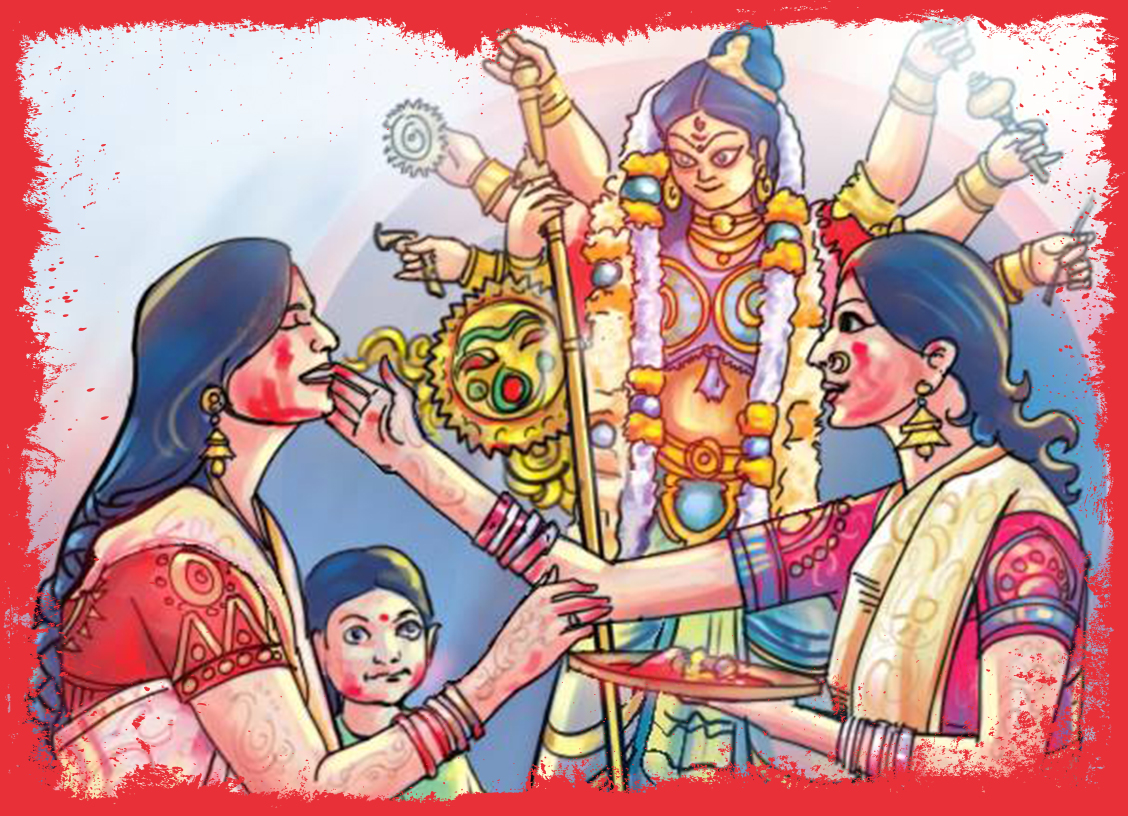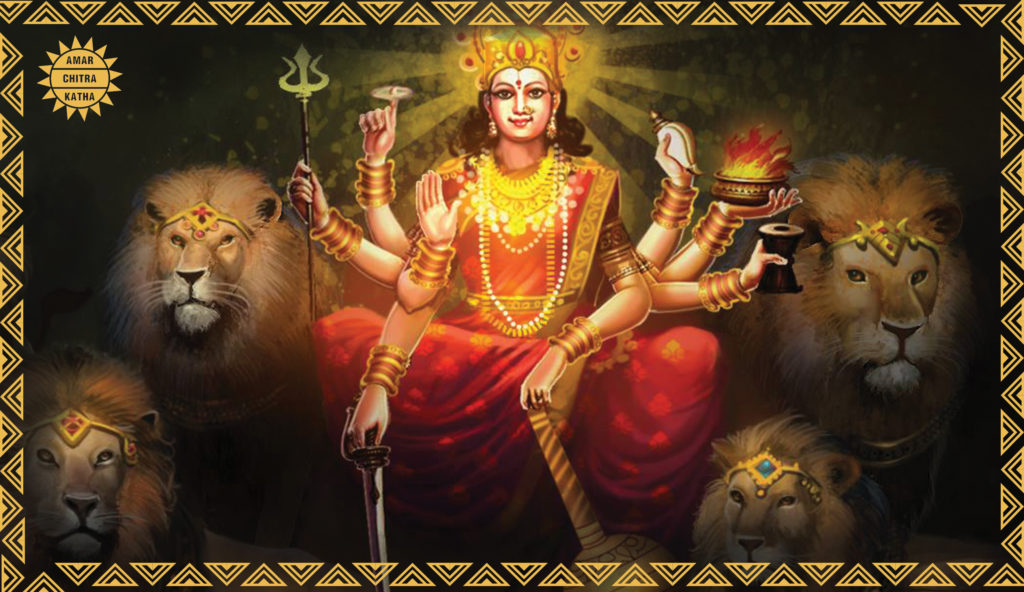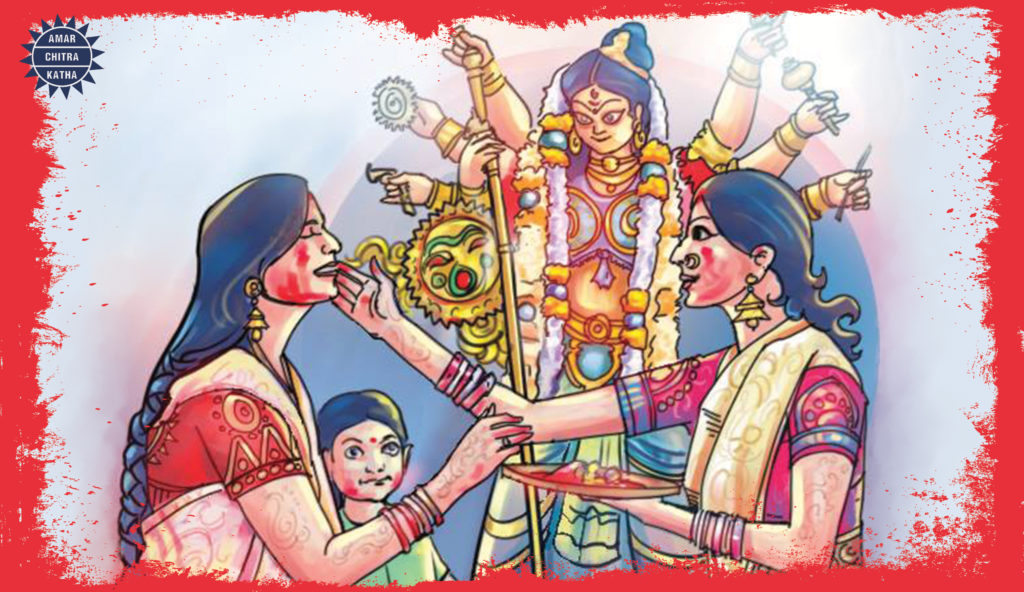When Durga Comes Home
- October 31, 2023


When Durga Comes Home
- October 31, 2023
By Reena I. Puri
Durga is the supreme source of energy and power in the universe. Called Ma or Mother Durga, she is the fierce protector of all who she gathers in her fold. Her strength is no match for the gods themselves as she combines the potent forces of Brahma, Vishnu and Shiva.
As the consort of Shiva, she wields immense power and yet, once a year she visits her maternal home, as all daughters in Indian tradition do.
To receive more such stories in your Inbox & WhatsApp, Please share your Email and Mobile number.
She begins her journey home on Mahalaya, the dark night of Amavasya or the new moon. Accompanied by her children, Lakshmi, Saraswati, Ganesha, and Kartikeya, she descends from the heights of Mount Kailasha, where she lives with Shiva, and goes to the warmth of her father’s house on earth. The people get up early that day to welcome her and fill her stay with happiness and festivity. Among Bengalis, the highlight of the morning is to listen to a recital of Mahishasura Mardini on the radio – a tradition followed for decades. The composition remembers the birth of Durga and the destruction of Mahishasura. It celebrates female power.
Mahalaya also marks the end of the period of ‘Pitri Paksha’. The 16 days during which people remember and give offerings in the name of three past generations of ancestors. The offerings are believed to help them on their way to swargaloka or heaven.

The mode of transport that the goddess comes and goes by foretells good or bad fortune for the people. The mode is decided by the day on which she arrives or ‘Ghatasthapna’ and the day on which she leaves, which is ‘Vijayadashami’. The vehicles she chooses between are the elephant, horse, palanquin, buffalo, rooster, man and boat.
If the Mother Goddess arrives on an elephant, it symbolises prosperity and a good harvest. If she comes on a horse, it means drought. A palanquin indicates epidemics, and a boat promises the fulfilment of the people’s desires and hopes. If she comes and departs on a horse it foretells great social and political unrest. The rooster indicates suffering, but the man foretells peace, good fortune and happiness.
It is believed that this year, in 2023, she has come riding on an elephant but goes back on a rooster.

Kolkata is the city that welcomes Durga with a fervour that is unmatched in the country. With a rich tradition of music, art and culture, Pujo – as it is known here – is a festival that gives the visitor a deep and intense cultural experience.
With the aura of female strength at its highest, this is one occasion when men walk a step behind their wives. Women dressed in their finest clothes and decked in glittering jewellery go from pandal to pandal praying to the goddess to give their families health and happiness. During the evening aarti or worship, the sound of their ululation coupled with the sound of bells and chanting fills the incense laden air.
Ma Durga lives in the hearts and minds of all who believe in her and her benevolence. Protector, nurturer and defender of good, may she destroy all that is evil in this world.
Celebrate Navratri with the stories of Goddess Durga from Amar Chitra Katha’s wide range of comics or on the ACK Comics app!
To receive more such stories in your Inbox & WhatsApp, Please share your Email and Mobile number.

Comic of The Month
The Naval Journey of India Book I
This book is the first of a three-book series that takes a deep and detailed look at India's Naval History and a deep insight into the lives of our men and women in white. But any series on the Indian Navy has to start at the very beginning - exploring India's celebrated maritime history. Join our little hero, Bharat, and his grandfather, Commodore Sagar, as they sail into the deep blue waters of time. Book I of The Naval Journey of India takes a sweeping look at India's maritime endeavours, how the seas impacted us over millennia and how the oceans made us who we are.